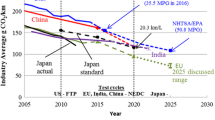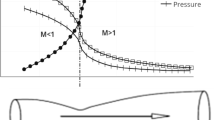Abstract
This paper reviews the studies on lacquer formation in medium-speed and low-speed engines. Lacquer mainly forms in the cylinder liner and fuel injection pump. This causes increased oil consumption, sticking of the fuel injection pump, scuffing in the cylinder liner, and so on. The mechanisms and causes of lacquer formation that have been proposed so far are introduced, and an explanation is given on the physical and chemical properties of lacquer formation by various analytical methods, such as melting test by acids, surface roughness measurement, pull-off test, and visual inspection. Moreover, a comparison is made of several experimental methods suggested in previous studies related to lacquer formation. Methods to prevent or remove lacquer formation in medium and low speed engines are also presented. In addition, this paper describes fundamental ongoing research.
Similar content being viewed by others
References
O. Buhaug, Deposit formation on cylinder liner surfaces in medium-speed engines, Ph. D. Thesis, Norwegian Univ. of Sci. and Tech. (2003) 1–289.
S. G. Dexter, Guidelines for diesel engines lubrication, 18 (2000) 1–10.
A. M. Liaquat, H. H. Masjuki, M. A. Kalam and I. M. Rizwanul Fattah, Impact of biodiesel blend on injector deposit formation, Energy, 72 (2014) 813–823.
N. F. Franz, B. Karin and L. Tibor, Optimizing the thermooxidation stability of gas turbine oils, CIMAC Congress, Vienna, 237 (2007) 1–7.
F. Sadeghi and N. Bolander, Determinitic modeling of honed cylinder liner friction, Tribology Transactions, 50 (2) (2007) 248–256.
S. Edberg and E. Landqvist, The impact of honing process parameters on the surface quality of cylinder liners, Master Thesis, KTH, 1-72.
O. Buhaug, Investigation of cylinder liner lacquers in the North Sea and Norwegian Sea regions, CIMAC Congress, Vienna, 186 (2007) 1–10.
A. B. F. Bros, A. Verhelst and D. Voogdt, CEC investigative report on liner lacquering, CEC-IL-21 Working Group, Liner lacquering, September (1991).
A. B. F. Bros, A. Verhelst, D. Voogdt and M. J. Cannon, CEC-IL-21 investigative report, Mechanism of loss of oil consumption control during operation of medium speed diesel engines, February (1993).
CEC Investigative Report, Resinous liner lacquering, September (2007) 1–6.
J. Barnes and P. Berentsen, Cylinder liner lacquering in distillate-fuelled medium speed engines and the development of an advanced anti-lacquer lubricant, CIMAC Congress, Kyoto, 22 (2004) 1–12.
N. Alberola, A. Vassel, H. Bourgognon and C. Rodes, The microcoking ELF/ECL test a new lubricant thermooxidation test based on original design, Lubrication Engineering, 47 (6) (1990) 480–484.
M. Chen and C. Wang, Quick coker test: a new and rapid engine oil detergency and thermo-oxidation test, Science in China (Series A), 44 (2001) 472–477.
S. H. Hong, J. K. Park and Y. S. Ryoo, Study on lacquer formation in combined of marine fuel oil and marine lubricant oil, Journal of the Korean Society of Tribologists and Lubrication Engineers, 31 (3) (2015) 148–156.
L. Zhu, Design optimization in the solution of piston ring sticking and carbon deposit, CIMAC Congress, Shanghai, 367 (2013) 1–5.
R. S. Chandel and S. R. Bala, Effect of welding parameters and groove angle on the soundness of root beads deposited by the SAW process, Proc. of Trends in Welding Research, Gatlinburg, Tennessee, USA (1986) 379–385.
R. W. Allen, The influence of marine fuel quality on lubrication oil performance, CIMAC Lubricants Working Group (1993) D53.
Guidelines for diesel engines lubrication–impact of fuel on lubrication, CIMAC, 18 (2000) 1–10.
R Mathai, R. K. Malhotra, K. A. Subramanian and L. M. Das, Comparative evaluation of performance, emission, lubricant and deposit characteristics of spark ignition engine fueled with CNG and 18 % hydrogen-CNG, International Journal of Hydrogen Energy, 37 (2012) 6893–6900.
Guidelines for diesel engines lubrication-oil degradation, CIMAC, 22 (2004) 1–60.
Guidelines for diesel engines lubrication–oil consumption of medium speed diesel engines, CIMAC, 17 (1999) 1–9.
F. A. Sautermeister, M. Priest, P. M. Lee and M. F. Fox, Impact of sulphuric acid on cylinder lubrication for large 2-stroke marine diesel engines: contact angle, interfacial tension and chemical interaction, Tribology International, 59 (2013) 47–56.
Guideline for the operation of marine engines on low sulphur diesel, CIMAC (2013) 1–22.
J. Logtenberg, Formation and consequences of deposits on pistons and cylinders in medium and high-speed diesel engines, Shell Nederland Verkomopmaatschappij B. V.
Technical considerations of fuel switching practices, API Technical Issues Workgroup (2009) 1–9.
Guidelines for diesel engine lubrication-impact of low sulphur fuel on lubrication of marine engines, CIMAC, 26 (2007) 1–16.
ISO 20340, Paint and varnishes-performance requirements for protective paint systems for offshore and related structures, Second edition (2009).
J. Rossetti and O. Buhaug, A comparative study of the use of fuel additives for the reduction of: environmentally harmful emissions, combustion chamber deposits, and specific fuel and oil consumption, CIMAC Congress, Hamburg (2001) 1219–1223.
J. Xie, X. Chen and C. Peng, Evaluation of the detergency of diesel engine oil with heat tube oxidation method I. Detergency of CC grade engine oil, Petroleum Processing Section (1995) N1:98-103.
J. Xie, X. Chen and J. Wang, Evaluation of the detergency of diesel engine oil with heat tube oxidation method II. Detergency of CD grade engine oil, Petroleum Processing Section (1995) N1:104-107.
A. J. Stipanivic, J. P. Schoonmaker, E. F. de Paz, J. K. Mowlem, J. E. Broas and C. Y. Thiel, Base oil and additive effects in the thermo-oxidation engine oil simulation test (TEOST), SAE Paper 962038 (1996).
M. T. Devlin, T. Dvorak, G. H. Guinther, J. M. Geuvremont, J. T. Loper, R. Sheets and T. C. Jao, Characterization of TEOST deposits and comparison to deposits formed on sequence III G pistons, SAE Paper 2009-01-2663 (2009).
A. Bejger and J. Drzewieniecki, Analysis of tribological processes occurring in precision pairs based on example of fuel injection pumps of marine diesel engines, Scientific Journal of the Maritime University of Szczecin, 41 (113) (2015) 9–16.
M. Soejima, Y. Wakuri, T. Hamatake and T. Kitahara, Studies on the tribology between cylinder liner and piston ring in marine diesel engine: past 30 years, CIMAC Congress, Kyoto, 46 (2004) 1–16.
G. Fleischhack and J. F. Chapuy, CIMAC and marine lubricant -16 years of “Working in a Group”, CIMAC Congress, Kyoto (2004) 1–11.
A. Igartua, R. Nevshupa, X. Fernandez, M. Conte, R. Zabala, J. Bernaola, P. Zabala, R. Luther and J. Rausch, Alternative eco-friendly lubes for clean two-stroke engines, Tribology International, 44 (2011) 727–736.
CIMAC guideline – future fuel scenarios and their impact on lubrication, March 5th (2014) 1–19.
Guidelines for diesel engines lubrication-oil degradation, CIMAC, 22 (2004) 1–60.
Guidelines for the lubrication of medium speed diesel engine, CIMAC, 29 (2008).
Project guide for HiMSEN engines – Lubricating oil system (2013) 85–87.
Author information
Authors and Affiliations
Corresponding author
Additional information
Recommended by Associate Editor In-Ha Sung
Sung-Ho Hong received his Ph.D. in the Department of Mechanical Engineering at Korea Advanced Institute of Science and Technology. He has worked extensively on Tribology at Engine and Machinery Division in Hyundai Heavy Industries. His current research interests include Fuel injection pump and journal bearing in medium-speed diesel engine, machine condition monitoring system based on lubricant analysis, diagnostics and prognostics.
Rights and permissions
About this article
Cite this article
Hong, SH. A literature review of lacquer formation in medium-speed and low-speed engines. J Mech Sci Technol 30, 5651–5657 (2016). https://doi.org/10.1007/s12206-016-1134-1
Received:
Revised:
Accepted:
Published:
Issue Date:
DOI: https://doi.org/10.1007/s12206-016-1134-1




